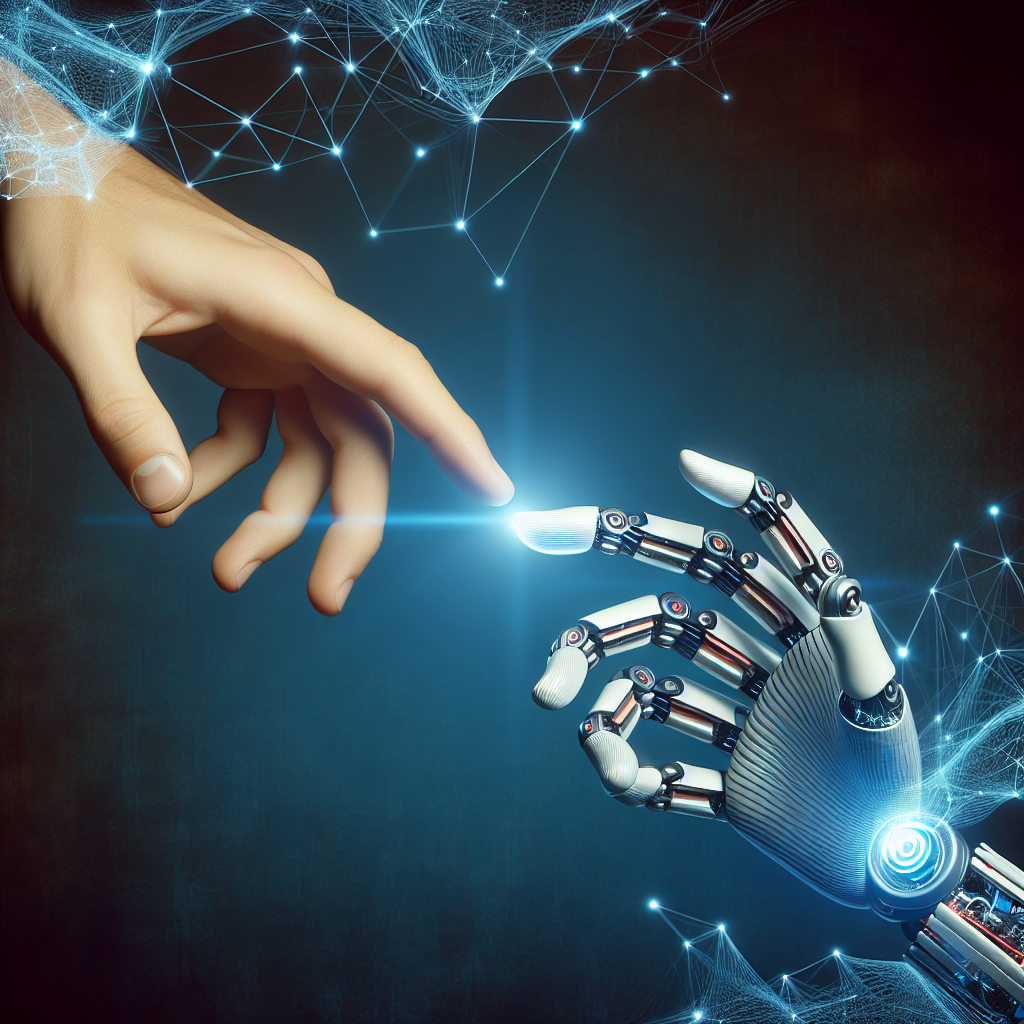
In today’s rapidly advancing technological landscape, the collaboration between humans and artificial intelligence (AI) has become more prevalent and significant than ever before. The name of the game is “Making the Most of Human-AI Collaboration”, where we delve into the exploration of how humans and AI can work hand in hand to achieve collective goals. As we witness the rise of AI across various industries, it is crucial to understand how to maximize the potential of this collaboration, ensuring that both humans and AI contribute their unique strengths, resulting in unprecedented success.
Understanding the Benefits of Human-AI Collaboration
In today’s rapidly evolving technological landscape, the collaboration between humans and artificial intelligence (AI) has become increasingly prevalent and valuable. The integration of AI systems with human expertise offers numerous benefits, enhancing decision-making, increasing efficiency and productivity, and improving accuracy and reliability.
Enhancing Decision-Making
Human-AI collaboration empowers individuals to make more informed and effective decisions. While AI algorithms excel at processing vast amounts of data and identifying patterns, humans possess invaluable qualities such as intuition, creativity, and critical thinking. By combining the analytical capabilities of AI systems with human judgment, decision-making becomes more robust and well-rounded.
For example, in healthcare, AI can assist doctors in diagnosing diseases by analyzing medical records, lab results, and imaging data, thereby reducing diagnostic errors and improving patient outcomes. However, the ultimate decision on treatment options is left to the healthcare professional, who incorporates their expertise, patient context, and ethical considerations to provide the best course of action.
Increasing Efficiency and Productivity
The integration of AI technologies in various industries has led to significant improvements in efficiency and productivity. While AI excels at processing large volumes of data quickly and accurately, humans can provide the necessary context and domain expertise to optimize processes and workflows.
In manufacturing, AI-powered robots and automation systems can handle repetitive and time-consuming tasks, allowing human workers to focus on more complex and strategic activities. This collaborative approach not only speeds up production but also reduces the risk of errors, enhances overall productivity, and frees up human resources for more value-added activities.
Improving Accuracy and Reliability
Human-AI collaboration can greatly enhance the accuracy and reliability of outcomes. AI systems are designed to minimize errors and biases in data analysis, but they are not infallible. By involving human experts in the decision-making process, potential gaps or biases in AI algorithms can be identified and mitigated, leading to more accurate and reliable results.
For instance, in financial analysis, AI algorithms can analyze vast amounts of market data and identify potential investment opportunities. However, human analysts can provide critical insights, challenge assumptions, and assess the broader economic context to ensure that investment decisions are made with a comprehensive understanding of the risks and benefits involved.
Identifying the Role of Humans in Human-AI Collaboration
While AI systems possess immense computational power and data processing capabilities, they have inherent limitations that can be complemented by human involvement. Understanding the role of humans in human-AI collaboration is crucial for harnessing the full potential of AI technologies.
Complementing AI’s Limitations
AI systems are highly specialized and excel in specific tasks, but they lack the adaptability and contextual understanding that humans possess. Humans can apply their domain knowledge, intuition, and experience to complement the limitations of AI systems, thereby achieving more comprehensive and nuanced outcomes.
For example, in customer service, chatbots powered by AI can handle routine inquiries and provide basic assistance. However, when faced with complex or unique situations, human customer service representatives can step in, leveraging their empathy and problem-solving skills to provide personalized and effective support.
Providing Contextual Understanding
One of the key advantages humans bring to AI collaboration is their ability to comprehend and interpret the context surrounding a given task or problem. Contextual understanding is essential for making informed decisions, considering ethical implications, and addressing nuanced situations that AI systems may struggle to navigate.
In the legal field, AI systems can assist lawyers in analyzing vast volumes of case law and precedents. However, it is the lawyer’s expertise and contextual understanding that enables them to develop persuasive arguments, consider unique circumstances, and apply legal principles to specific cases effectively.
Judgment and Ethical Considerations
AI systems, while powerful, lack the ability to make subjective judgments or consider the ethical implications of their actions. Human involvement is essential for incorporating ethical considerations, empathy, and moral reasoning into decision-making processes.
For example, in autonomous vehicles, AI algorithms can navigate and analyze traffic conditions to ensure safe transportation. However, it is the human driver who possesses the judgment to make split-second decisions in unforeseen circumstances, considering factors like potential harm to pedestrians, ethical dilemmas, and legal responsibilities.
Leveraging AI’s Strengths in Human-AI Collaboration
While humans play a vital role in human-AI collaboration, it is equally important to recognize and leverage the strengths of AI systems to optimize their capabilities and achieve better outcomes.
Processing Large Volumes of Data
One of the most significant advantages of AI systems is their ability to process large volumes of data quickly and accurately. Humans can provide input and guidance on the relevant data sources, establish appropriate data governance frameworks, and review the analyzed results to ensure comprehensive and reliable insights.
For instance, in climate science, AI algorithms can analyze vast amounts of weather data, satellite imagery, and climate models to detect patterns and predict long-term trends. Human scientists then interpret these findings, validate their accuracy, and assess the potential implications and uncertainties involved.
Automating Repetitive Tasks
AI systems excel at automating repetitive and mundane tasks that consume a significant amount of time and effort. By offloading these tasks to AI, humans can focus on more complex and strategic activities that require creativity, problem-solving skills, and critical thinking.
In the field of document review, AI-powered systems can automatically classify and extract information from large volumes of documents, reducing the time and effort required by human reviewers. This speeds up the overall review process and allows human reviewers to focus on higher-level analysis, such as identifying key insights, assessing risks, and making informed decisions based on the extracted information.
Performing Complex Analytical Tasks
AI systems can handle complex analytical tasks that require advanced algorithms and computational power. By leveraging AI’s capabilities, humans can obtain valuable insights, uncover patterns, and optimize decision-making processes in various domains.
In the field of finance, AI algorithms can analyze financial data, market trends, and economic indicators to identify investment opportunities and assess risk levels. Human financial analysts can then interpret and contextualize these insights, taking into account market dynamics, regulatory frameworks, and industry-specific knowledge to make well-informed investment decisions.
Establishing Trust and Transparency in Human-AI Collaboration
Building trust and transparency in human-AI collaboration is crucial for ensuring the successful integration and acceptance of AI systems. Understanding AI’s decision-making process, addressing bias and fairness, and enabling explainability and interpretability are essential steps in fostering trust between humans and AI.
Understanding AI’s Decision-Making Process
To establish trust, it is vital for humans to understand how AI systems make decisions. AI algorithms can be complex and opaque, often referred to as “black boxes.” Efforts should be made to develop transparent AI models and methodologies, allowing humans to comprehend the underlying logic and factors influencing AI’s outputs.
By providing humans with visibility into the decision-making process, they can assess and validate the outputs, identify potential biases or errors, and make informed judgments based on AI recommendations.
Addressing Bias and Fairness
AI systems are only as unbiased and fair as the data they are trained on. It is crucial to address the biases inherent in training data, ensuring that AI systems do not perpetuate or amplify social inequalities or discrimination.
Regular audits and reviews of AI systems should be conducted to identify and mitigate any biases in data collection, model training, and algorithmic decision-making. By proactively addressing bias and fairness concerns, human-AI collaboration can promote equal opportunities, uphold ethical standards, and provide more inclusive and trustworthy outcomes.
Enabling Explainability and Interpretability
The ability to explain and interpret the decisions made by AI systems is essential for building trust and facilitating effective human-AI collaboration. Humans need to understand how AI arrives at its recommendations, especially in critical domains such as healthcare or financial decision-making.
By developing algorithms and models that provide explanations and justifications for AI-generated outputs, humans can evaluate the reasoning behind AI’s recommendations and ensure that they align with the context, ethical considerations, and domain expertise. This enhances accountability, strengthens decision-making processes, and fosters mutual understanding between humans and AI.
Fostering Effective Communication in Human-AI Collaboration
Effective communication is key to harnessing the full potential of human-AI collaboration. Building a shared vocabulary, establishing clear communication channels, and embracing iterative feedback and improvement are crucial elements for seamless collaboration.
Building a Shared Vocabulary
In human-AI collaboration, it is essential to establish a shared vocabulary and understanding of key concepts and terminology. Technical jargon often used in AI should be translated and explained in a way that is accessible to non-technical stakeholders.
This shared vocabulary enables effective communication between humans and AI systems, reduces misunderstandings, and facilitates mutual comprehension of goals, challenges, and strategies. It also promotes collaboration and fosters a sense of inclusivity, making AI more approachable and user-friendly.
Clear Communication Channels
Establishing clear communication channels is essential for efficient collaboration. Humans should have avenues to provide feedback, seek clarification, and express concerns or suggestions regarding AI-generated outputs and recommendations.
These communication channels should be easily accessible and user-friendly, ensuring that humans feel empowered to voice their opinions without hesitation. By promoting open and transparent communication, human-AI collaboration can thrive, enabling continuous improvement and addressing emerging challenges effectively.
Iterative Feedback and Improvement
Human-AI collaboration should be an iterative and evolving process. Humans should provide feedback on AI outputs and recommendations, discussing areas of improvement, and suggesting modifications to enhance the overall performance and reliability of AI systems.
By embracing continuous feedback loops, human-AI collaboration can adapt to changing requirements, incorporate new insights, and refine AI models and methodologies. This iterative approach promotes mutual learning and growth, ensuring that AI systems align with human expectations, values, and objectives.
Enhancing Skillsets for Human-AI Collaboration
To fully leverage the benefits of human-AI collaboration, individuals need to enhance their skillsets to effectively interact with AI systems. Developing AI literacy, promoting cognitive flexibility, and strengthening interpersonal skills are essential for successful collaboration.
Developing AI Literacy
AI literacy refers to the knowledge and understanding of AI technologies, their capabilities, limitations, and impact on society. Individuals involved in human-AI collaboration should invest in developing AI literacy to foster informed decision-making and effective communication.
By staying updated with the latest advancements in AI and its applications, individuals can make better use of AI tools and systems, interpret AI-generated outputs correctly, and critically evaluate AI recommendations. AI literacy empowers individuals to become active participants in human-AI collaboration, making informed choices and contributing meaningfully to AI-enabled workflows.
Promoting Cognitive Flexibility
Cognitive flexibility is crucial for adapting to the dynamic and evolving nature of human-AI collaboration. It refers to the ability to switch between different tasks, perspectives, and problem-solving approaches, seamlessly integrating AI systems into existing workflows.
By cultivating cognitive flexibility, individuals can embrace AI as a complementary tool, leveraging its strengths while adapting and refining their own expertise. This flexibility enables individuals to navigate complex and uncertain situations, make trade-offs, and optimize human-AI collaboration in diverse domains.
Strengthening Interpersonal Skills
Collaborating effectively with AI systems requires strong interpersonal skills. Humans need to communicate, empathize, and build trust with AI algorithms and systems, treating them as cooperative partners rather than threats to job security or autonomy.
Skills such as active listening, empathy, and effective teamwork play a vital role in successful human-AI collaboration. By embracing a human-centered approach, individuals can foster trust and understanding, facilitating a harmonious collaboration that maximizes the potential of AI while preserving human values and decision-making authority.
Mitigating Risks and Ethical Considerations in Human-AI Collaboration
While human-AI collaboration holds immense promise, it is essential to address potential risks and ethical considerations. Guarding data privacy and security, ensuring accountability and responsibility, and proactively addressing unintended consequences are crucial steps in mitigating potential challenges.
Guarding Data Privacy and Security
Data privacy and security are paramount in human-AI collaboration. Personal and sensitive data must be handled securely, ensuring that unauthorized access or data breaches do not compromise individuals’ privacy or expose them to potential harm.
Robust data governance frameworks, encryption techniques, and secure data storage practices should be implemented to protect data confidentiality. Additionally, transparency regarding data usage and obtaining informed consent are essential to build trust and foster responsible human-AI collaboration.
Ensuring Accountability and Responsibility
As AI systems become increasingly integrated into decision-making processes, it is crucial to establish clear lines of accountability and responsibility. Roles and responsibilities of humans and AI systems should be well-defined, ensuring that accountability is attributed to the appropriate parties.
In areas such as autonomous vehicles or healthcare diagnostics, clear protocols must be in place to delineate when humans should intervene, override AI recommendations, or take ultimate responsibility for decisions. This ensures that ethical and legal considerations are upheld, and potential risks or malfunctions are addressed promptly.
Addressing Unintended Consequences
Human-AI collaboration must actively consider and address unintended consequences that may arise from the use of AI systems. Bias amplification, unintended harm, or unforeseen errors can occur without proper oversight and continuous monitoring.
Regular audits, risk assessments, and evaluations should be conducted to identify any unintended consequences and take corrective measures. A proactive approach to addressing unintended consequences is essential for maintaining trust, transparency, and the ethical soundness of human-AI collaboration.
Overcoming Challenges in Human-AI Collaboration
While human-AI collaboration offers numerous benefits, it is not without its challenges. Overcoming resistance and fear of AI, avoiding overreliance on AI, and effectively integrating and implementing AI systems are key considerations for ensuring successful collaboration.
Resistance and Fear of AI
Resistance and fear of AI can hinder the adoption and acceptance of human-AI collaboration. Concerns about job displacement, loss of autonomy, or ethical implications may lead individuals to resist or reject the integration of AI systems.
To address resistance, it is crucial to foster understanding and awareness about AI technologies, their capabilities, and potential benefits. By transparently communicating the role of humans in human-AI collaboration and emphasizing the added value AI brings rather than replacing humans, fear and resistance can be mitigated.
Overreliance on AI
While AI systems can significantly enhance decision-making and productivity, it is important to avoid overreliance on AI and recognize its limitations. Blindly accepting AI-generated outputs without critical evaluation can lead to erroneous or biased outcomes.
Maintaining a healthy balance between human judgment and AI recommendations is crucial. Humans should be encouraged to exercise discretion, challenge AI outputs when necessary, and provide valuable insights that AI systems may lack. Continuous learning and development of AI models should also be prioritized to improve their performance and address identified limitations.
Integration and Implementation Issues
Integrating and implementing AI systems effectively can present significant challenges. Technical issues, resource constraints, or incompatible workflows may hinder the seamless collaboration between humans and AI.
To overcome these challenges, a well-structured integration plan should be developed, considering factors such as organizational culture, infrastructure, and employee training. Collaboration between AI experts, domain experts, and end-users is crucial for addressing technical roadblocks and ensuring that AI systems align with specific business needs and requirements.
Case Studies on Successful Human-AI Collaborations
Numerous case studies demonstrate the success of human-AI collaboration across various domains. These examples highlight the value of combining human expertise with AI capabilities to achieve superior outcomes.
Medical Diagnosis and Treatment
In the field of medicine, human-AI collaboration has proven instrumental in enhancing diagnosis and treatment. AI systems can analyze medical images, patient records, and genetic data to assist doctors in accurate diagnosis and personalized treatment plans. By leveraging AI’s computational power and human physicians’ clinical expertise, the accuracy and efficiency of medical processes are significantly improved, leading to better patient outcomes.
Customer Service and Support
Customer service and support have been revolutionized by human-AI collaboration. AI-powered chatbots and virtual assistants can handle routine inquiries, provide instant responses, and streamline customer interactions. Human customer service representatives complement this technology by handling complex or emotionally sensitive requests, providing empathetic support, and resolving nuanced issues that AI may struggle to address. This combination enhances customer satisfaction, reduces response times, and optimizes service quality.
Financial Analysis and Investment
Financial analysis and investment decision-making have been enhanced by human-AI collaboration. AI algorithms can analyze vast amounts of financial data, detect patterns, and generate investment recommendations based on historical trends. Human financial analysts provide critical insights, consider qualitative factors, and apply their experience and judgment to make informed investment decisions. This collaborative approach combines AI’s analytical capabilities with human expertise, leading to well-rounded investment strategies and improved financial outcomes.
Future Trends in Human-AI Collaboration
As human-AI collaboration continues to evolve, several future trends are expected to shape its trajectory and expand its possibilities.
Augmented Intelligence
Augmented intelligence refers to the concept of enhancing human intelligence with AI technologies. Rather than replacing humans, AI systems are designed to augment human decision-making, providing real-time insights, recommendations, and adaptive learning capabilities. Augmented intelligence enables humans to make more informed decisions, streamline workflows, and achieve higher levels of productivity, setting the stage for even more fruitful collaboration between humans and AI.
AI-Decision Support Systems
AI decision-support systems aim to assist humans in complex decision-making processes across various domains. These systems incorporate AI algorithms, data analytics, and simulation models to analyze massive amounts of data, evaluate potential outcomes, and generate actionable insights. By presenting humans with comprehensive and reliable information, AI decision support systems enable individuals to make evidence-based decisions, optimize resource allocation, and mitigate risks effectively.
Human-Centered AI Development
Human-centered AI development emphasizes the design and development of AI systems with a focus on human needs, values, and ethical considerations. Incorporating interdisciplinary perspectives, such as human-computer interaction and social sciences, human-centered AI development aims to create AI technologies that align with human desires, aspirations, and well-being. By prioritizing human agency, autonomy, and the common good, human-centered AI development fosters collaborative and responsible human-AI interaction, ensuring that AI technologies serve the best interests of humanity.
In conclusion, human-AI collaboration holds enormous potential for enhancing decision-making, increasing efficiency, and improving accuracy. By leveraging the strengths of humans and AI systems, complementing their respective limitations, and fostering effective communication and trust, we can maximize the benefits of this collaboration. Building AI literacy, promoting cognitive flexibility, and addressing ethical considerations are essential for successful integration. With continued advancements and future trends emphasizing augmented intelligence, AI-decision support systems, and human-centered AI development, the collaboration between humans and AI holds a promising future of innovation and progress.






